Never give up! Endurance Rider, Rachelle, Overcomes her Setbacks to Reach her Dreams
Overcoming Complications to Achieve her Dreams
Rachelle du Plessis is an endurance rider in South Africa. She and her husband, Martin du Plessis, breed, train and compete endurance horses. Rachelle was diagnosed with MS in 2002 and continues to be active in the horse world in spite of her diagnoses. Recently, one of Rachelle’s horses, Lupita, began having trouble with her feet, causing Rachelle to transition her from traditional shoes to barefoot. She reached out to Scoot Boot about using Scoot Boots to help Lupita continue to compete in endurance competitions. Scoot Boot arranged the following interview with both Rachelle and Martin du Plessis.
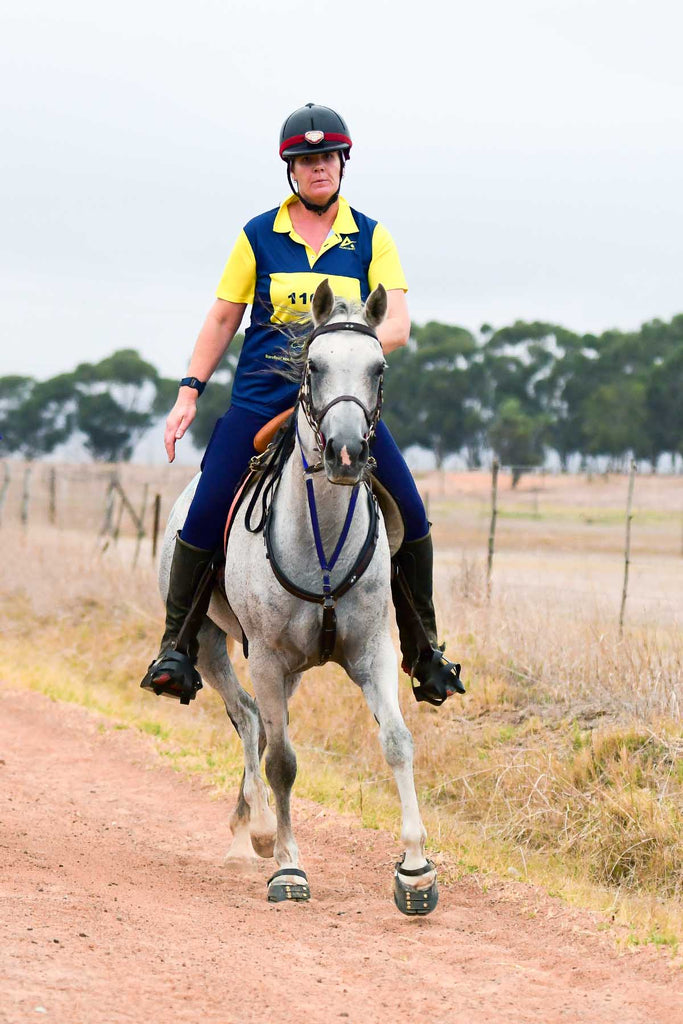
You are an Endurance Rider. Can you Tell us a Little More About Yourself?
I grew up in a farming valley in South Africa in a very small town. My family farmed and had cows, but we never actually had horses. There were no riding schools in the area. After going to university, I got a job in Franschhoek. Being an introvert, I had a hard time making friends and got very lonely. I decided that I needed to do something so I started horse riding lessons at the age of 23. The first few lessons, I hated it. On the fifth lesson we went into the mountains and that changed everything for me. From then on, horses were a big part of my life.
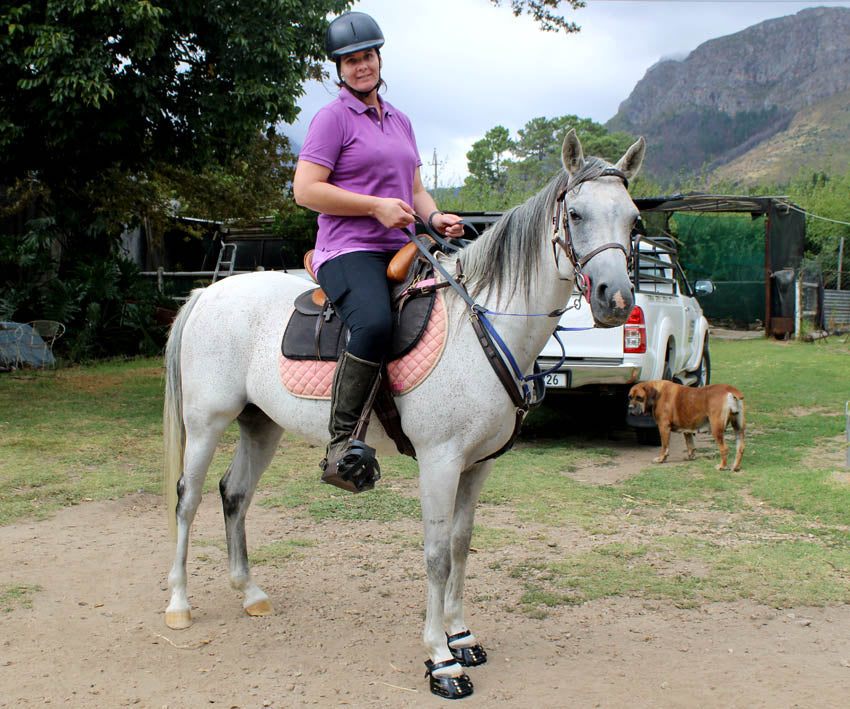
What got you Into Endurance Riding? How did it all Begin for you?
My husband is quite the horseman and has been involved in riding all his life. When I met him in 2009 he had moved to Franschhoek and he decided that he wanted to give endurance riding a try. I started riding with him and training with him and thought, since I was already doing the work, I might as well actually compete so I started riding endurance in 2012.
You Follow the Training Program of Laura Seeger. Can you Tell me More About her and her Program?
I like to have a program and a plan when I ride. I went online and came across Laura Seeger. She is actually a barefoot rider and one of the top endurance horse breeders in South Africa. I love her training articles and the way she explains in-depth how to train and develop horses for endurance. It gave me a detailed guideline to follow and helped me understand how and why we do things.
What Does a Typical Training Session Look Like for you?
My husband and I both work full time jobs, so we have to train outside of work hours. During the week, we do shorter, more intense work after we get home in the evenings. We do a lot of walking up the mountain and walking down the mountain. While I’ve been transitioning my horses to barefoot, we have been riding up the mountain and walking in-hand down the mountain to not strain their feet. On the weekends, we trailer the horses somewhere where we can do 10-20km rides and include trotting and cantering.
You were Diagnosed with MS in 2002. It’s Incredible That you Have Continued to be so Involved With Horses in Spite of Your Diagnosis. What Challenges Have you Faced as a Rider with MS? Can you Speak a Little About how it was for you Deciding to Move Forward With Riding After Your Diagnosis?
First, I want to describe what MS is because some may not know. MS is considered an autoimmune disease in which the body’s immune system attacks its own tissues, therefore the immune system malfunction and destroys the myelin (the fatty substance) that coats and protects nerve fibers in the brain and spinal cord. It interferes with how my brain is able to tell my body to do what I want it to. The signals from my brain don’t always get to where they are supposed to. I was diagnosed because I lost the use of my legs. I was very fortunate to have an extraordinary GP who sent me to the neurologist right away. The neurologist was able to detect what was wrong within a week of me being in the hospital. That was two months before my 26th birthday in 2002.
After my diagnoses, I was very fortunate to have a wonderful support system, including my parents, around me. I enjoyed horse riding so much that I didn’t want to give it up. I thought, “If I can’t walk, my horse can walk for me.” I found this amazing Fresian cross mare named “Mamma Mia” and her name says it all. She was so patient, she took me where I wanted to be. She never became upset when my left side was unbalanced with my right. She never caused any hassle with anything. After a few months of riding, I saw that all of my muscles started getting stronger and stronger. My neurologist couldn’t understand how it was happening. It was amazing. My refusal to stop riding started with Mamma Mia.
Mamma Mia helped me both physically and mentally to get stronger. She also helped me to meet other people, which was important for me. Because of her, I could be part of a local joy ride club. She also helped me to be a better rider. When I got her, I had only been riding for a little over 2 years so I wasn’t very experienced. But because I had her, I made friends with other people who had horses. One of my friends had a horse named Singi who I also began to ride, and when my friend died on 1st January 2009, I adopted Singi.
What Ongoing Challenges do you Face With MS?
Heat, stress and exhaustion all make MS worse. I need to inject myself every second night with my medication. The medication makes you feel like you have been thrown under a bus, but then again I am very lucky to have minimal negative effects of the injection. My left leg is not strong, so I know my seat is not perfect. The weaker leg also means bad balance in my seat, but my horse, Lupita, is coping very well. Lupita gets Fascia treatments and regular chiro sessions to help. I actually stopped doing endurance in 2014 due to a lot of MS relapses, and was in the hospital often. But, my neurologist gave me the go ahead on 18th November 2019. I am ready for 2020.
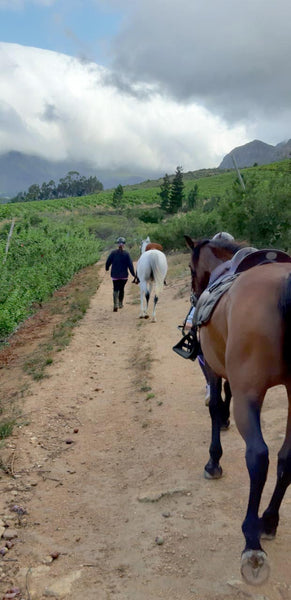
Do you Have a Favourite Competition Memory?
I think it would be the 80 km ride I finished a few years ago. I was told, “You can’t do it, MS won’t let you” and I did do it. I did that ride on Singi and was so proud to have finished. Even better, we finished very well with a good heart rate.
Were There any Times That Were Particularly Challenging That Made you Think ‘What am I Doing This for?’. Were There any Particular Moments like That That Stand out for you?
There are two. The first was in March 2013 during the Darling ride. It was very hot that day. They say it was the hottest day in 40 years. MS does not like the heat. My husband and I were starting to be more competitive at that time. I entered an 80 km race. I completed the first 30 km leg of the ride, but started having trouble around 15 km of the second leg. My husband noticed that I was falling behind. He said, “Rachelle come on, come on, you’re falling back.” My muscles had totally gone numb. I couldn’t feel my feet, my hands started to go numb, I started to be nauseous. At the water point he waited for me and when he saw me, he knew something big was wrong. I told him, “I just feel very, very bad.” It was sad for me because he retired on the ride as well and took my reins and led me back.
The second one was in 2018 I had a very bad fall off Lupita. I hit my head really hard. After a few weeks I started feeling very bad and would black out sometimes. I had a little bit of trouble with seizures. The doctor said that it was only temporary, but it was sad to not be able to ride for a while.
What's the Best Piece of Advice You've Been Given?
It’s been from my husband, Martin. Even though we argue and sometimes agree to disagree about horses, when I say “Lupita can’t do this or that” or make excuses he says, “Rachelle, you are the rider. You ride the horse, the horse doesn’t ride you.”
You Have a 9 year old Arab Mare Named Lupita. Can you Tell us About her?
She is actually bred by a friend of ours. The friend contacted us and asked if we would be able to wean her. We had the space so we agreed. After a month or two, we liked her so much that we decided to buy her at 10 months old. When she was a year old, we took her to Carnarvon where she grew up. It’s a great area for horses to grow up. Their feet get hard and they have many hectares to run on. She grew up with many other young ones. We would go and visit her periodically. In 2014, we decided to breed her. After her foal was weaned, we started her training. She is very smart and has been an easy horse to train and work with. A very quick learner. Sometimes I think she is too smart for me.
You Have Recently Taken her Barefoot. Can you Tell us why you Chose to Switch to Barefoot?
When she came out of the Carnarvon she had very nice, strong feet. When we put shoes on, her feet became very brittle. The shoes would come off all the time and the nails had to be put higher and higher. I gave her supplements and tried everything to strengthen her feet, but they just worsened. In August of 2019, I came home one day and she was very lame. She was on three legs. Her front right foot was so hot. I called my husband and he came home and took off all her shoes. Her foot had become so bruised and it seemed like it happened overnight. We put on a poultice for the next few days. Nothing seemed to be helping. When I was talking to a friend about the issue, she recommended Engela who is a barefoot farrier. Engela came out right away to take a look. She said it was definitely an abscess that had not come through yet. She trimmed all of Lupita’s hooves and put on a poultice. The next morning she was actually trotting. It was amazing. We kept soaking the foot for the next few days and things continued to improve. We also changed her diet to a laminitis friendly diet. A few days later, one of her back feet had an abscess come through as well. Engela also gave me some supplements to start Lupita on. Because of the improvement we were seeing, I thought, “why not go ahead and leave her barefoot for the off season to let her feet grow”. To my amazement, since going barefoot her feet have grown extremely well and have even began to spread. In two more trims, all the signs of her abscesses and hoof stress will be gone. Her foot shape and health have already improved so much.
Were you Worried That Going Barefoot Would Negatively Affect Lupita’s Endurance Abilities?
No, I don’t worry about the endurance rides. I just want her to be happy. If you have a horse with no feet, you don’t have a horse. She’s happy barefoot and I want her to be happy. My hope is that the Scoot Boots will help her be able to compete in endurance even though she is barefoot.
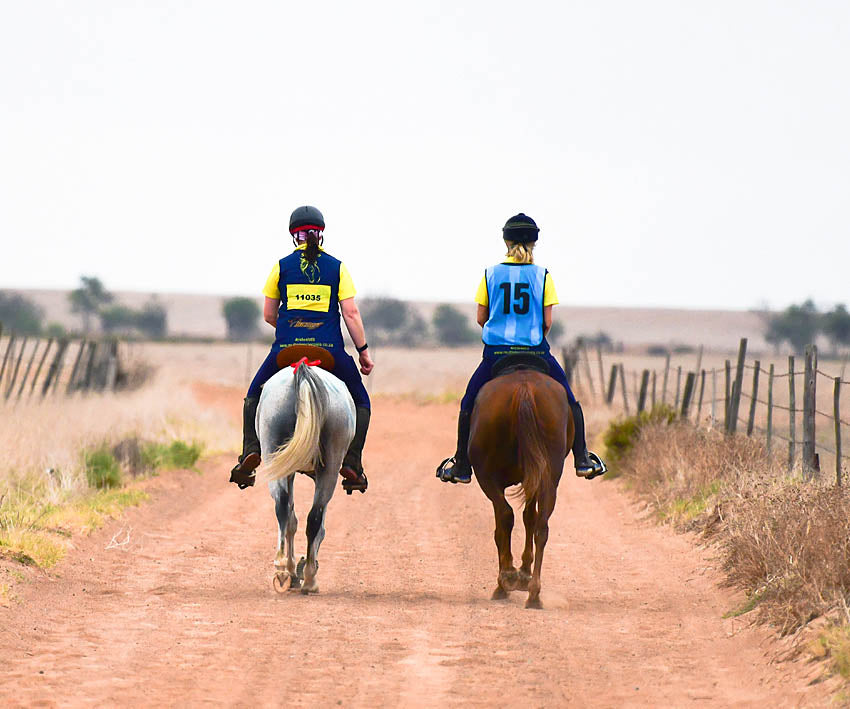
How Important Would you say it's Been to Work With a Barefoot Specialist Farrier?
It has been essential. Very important. Normally, because our lives are so hectic, the shoes and the farrier are an afterthought. With Lupita, she’s had so many problems, I became very involved. I have been there for each trim asking questions and learning why things are done certain ways and learning about the hoof. It’s really convinced me about how much better being barefoot is for Lupita’s feet. It’s amazing to see the difference in her feet in such a short time.
You Started Your Barefoot Transition in August when Lupita was very Lame. What has the Timeline Looked Like for her Barefoot Transition and how are Things Going now?
We pulled the shoes off on August 28th. At the end of September, I started in-hand walking over different surfaces. At the end of October we started walking rides and mid January we were able to trot. I really believe in Engela now. I’ve been so worried about whether Lupita’s feet would come out right and if she could be healthy again. We seem to be seeing the light at the end of the tunnel. It is so important to work with a knowledgeable farrier.
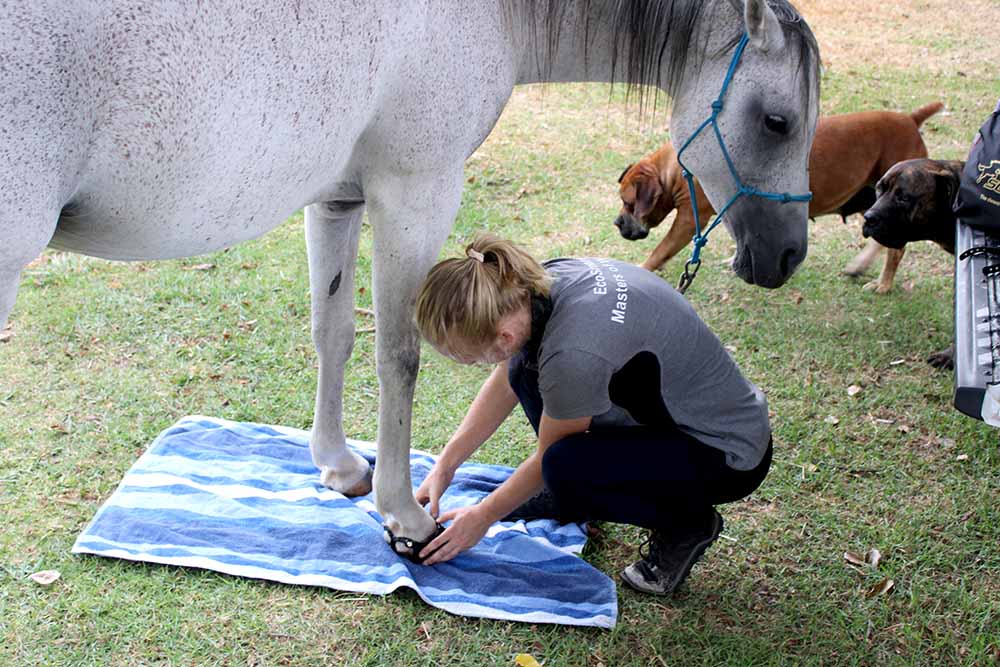
Engela fitting Scoot Boots on Lupita
How do you use Your Scoot Boots with Lupita?
Lupita doesn’t wear the boots 24/7. I use them for the training rides and long distances to help protect her feet. They let me give her the protection she needs on rides while still allowing her to remain barefoot.
What Advice Would you Give Other Endurance Riders Thinking About Taking Their Horses Barefoot?
Rachelle - My husband, Martin, would like to comment on this.
Martin - Make sure you have a farrier that can do barefoot trimming. They must be a professional at their job. It is crucial. Anyone can say they can shoe and trim, but make sure you get a truly knowledgeable person if you want to go barefoot. I have never been a barefoot advocate, but I must say, and I never wanted to admit it in front of Rachelle, it is really paying off. I can’t believe the difference being barefoot is making in these horses.
Rachelle - In four months time, I am so happy with the decision to go barefoot. The jury is still out on what Martin will decide, but I think he’s seeing the benefits. Endurance riders in our community think you cannot compete barefoot. They say you will lose the boots along the way and they aren’t worth the money. I aim to prove that you can ride competitively in boots. I want to show people, like with my MS, that it can be done. I want to prove that you can ride endurance competitively with Scoot Boots.
Where can we Look Forward to Seeing you This Upcoming Season?
In 2020 we will be training quite a bit and my goal is to complete and get Lupita through the novice phase without any lameness or eliminations. In 2023/2024 we look forward to doing the grueling Fauresmith ride. For those that don’t know, this is a ride that is on the bucket list of every South African endurance rider. It is one of the toughest endurance rides in the world. It is 200 km over 3 days and very extreme conditions. It is very, very cold. It takes a toll on the horses and the riders so there is a lot of training and qualifications required to compete. We will be training for the next 4 years and aiming to do that ride in 2023.
What is the Best way for People to Connect to you and Follow your Journey?
I am currently setting up my Facebook page, Stenco Arabiere. It will include information and awareness about MS and I will also include about how the Scoot Boots are with each ride. My farrier, Engela, will also comment there about how Lupita’s feet are progressing.
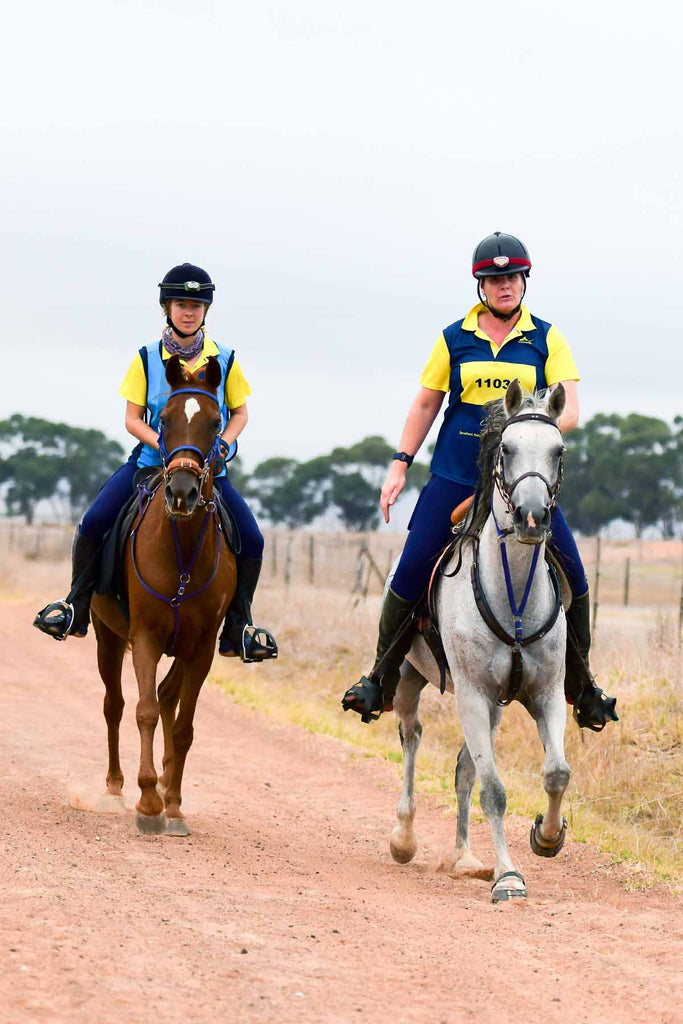
A Special Thanks from Rachelle
I want to thank Scoot Boots very much for entrusting their product to me. I also want to thank Engela Potgieper for her assistance in this time of transition. And thank you to the farmers of Franschhoek for letting us train over their properties. They are so nice to us, we wouldn’t be able to train the same without them. And also, thank you to my husband, Martin, for staying by my side. I know that living with me and my friend MS is not always an easy task. On the days when I can’t get out of bed, he is in the barn cleaning stalls, feeding horses, and training for me. I couldn’t do it without him.
Building a Supportive Barefoot Community
The team at Scoot Boot believe passionately in the barefoot horse and strive to build a supportive community of barefoot horse lovers.
Find more information about using Scoot Boots here.
